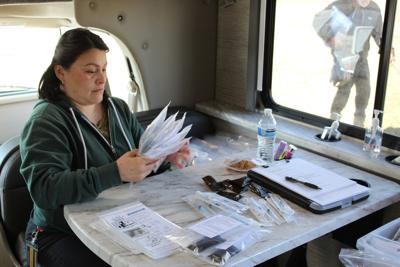While numbers are not yet final, the number of drug overdose deaths in Yakima County last year is the second highest recorded.
Jim Curtice, the Yakima County coroner, said his office has counted 96 confirmed overdose deaths in 2023. He said more than a dozen other deaths are still being investigated for a connection to drug use.
The county had 98 overdose deaths in 2021 and 81 deaths in 2022, according to the coroner's office. The use of the powerful opioid fentanyl has been part of the issue, mirroring a nationwide trend.
Curtice, who was part of a Yakima Health District Board of Health meeting on Wednesday, also reported a cluster of seven overdose deaths within five days of one another in late December.
Efforts to help
To combat that rising number, the Yakima Health District has dedicated thousands of dollars and brought on new staff and services. As it steps into 2024, the health district is looking to expand its reach further into the Lower Valley.
The district has increased its efforts to provide overdose reversal drugs such as naloxone.
In the first half of 2023, efforts led by Melissa Sixberry, director of disease control, and Lilian Bravo, director of public health partnerships, resulted in the health district purchasing 1,500 boxes of Narcan, the brand name for a device that delivers naloxone.
Along with Narcan, the health district also bought two vending machines to dispense the life-saving drug. By late summer, the vending machines had been placed at the OIC offices on Fruitvale Boulevard and outside of the Yakamart in Toppenish.
Bravo told health board members the two vending machines had dispensed 250 boxes of naloxone since Nov. 1. The Yakima vending machine dispensed 118 kits of naloxone while the machine in Toppenish dispensed 132.
Around the same time, the health district had developed a new program that would connect local businesses and their staff with multiple doses of Narcan and training on how to use it.
Ten businesses, including a church, a shelter and a notary office, opted into the program. Health district staff distributed 100 doses of Narcan and trained 175 people on how to use it.
On top of creating these two new services, the health district continued working with the county’s drug-using population through its harm reduction program. The program, which has been operating for more than 30 years, offers social service referrals, syringe exchanges, free condoms and other services.
Bravo said the health district shared 300 kits of naloxone with Yakima Valley Emergency Management, which distributed the kits to first responders, including 100 to the Yakima Fire Department and 72 to the Washington State Patrol.
In 2023, the Yakima Health District exchanged 79,452 needles and distributed 1,220 fentanyl test strips and 2,228 boxes of naloxone.
First month of 2024
In the first month of the new year, Sixberry said, the health district had already had 138 interactions with people through the harm reduction program.
She said the majority of clients the health district worked with in January were white males 30 years and older.
The health district exchanged 5,900 needles, distributed 105 fentanyl test strips and gave out 23 sharps disposal containers, which are the red containers used to throw away used needles.
In addition, health district staff distributed 215 doses of naloxone.
Sixberry said 52 of those doses were reported as being used to prevent an overdose. She said at least 47 of the people who received the dose lived, while at least three died. The majority of the overdoses, 28, took place in public places like on a street or a shelter. Twenty-two occurred in private residences.
To expand harm reduction services to the Lower Valley, a goal voiced by health district staff multiple times last year, Sixberry said the district was finalizing a contract to operate out of a Lower Valley location with a tentative opening date of March 5.
Sixberry said all the services offered in the Upper Valley will be available to Lower Valley residents.
Editor's note: This article was corrected to reflect it was Melissa Sixberry who read off the harm reduction program statistics for January 2024. In addition the Yakima Health District has dedicated thousands of dollars toward its harm reduction program in recent years, not millions.









(1) comment
When are we going to get serious about putting away the dealers?
Log in to reply
Comments are now closed on this article.
Comments can only be made on article within the first 3 days of publication.